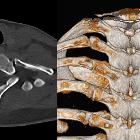Lumbarized S1 segment












Lumbosacral transitional vertebrae (LSTV) are a relatively common variant and can be seen in ~25% (range 15-35%) of the general population . Non-recognition of this variant and/or poor description in the report can lead to operations or procedures performed at the wrong level.
Depending on the number of thoracic vertebrae, lumbar vertebrae and sacral segments they can be thought of as a lumbarized S1 segment or sacralized L5 segment. There can be a varying degree of transition, from partial to complete fusion.
Lumbarization of S1
- assimilation of S1 to lumbar spine
- less common than sacralization, occurring in ~2% of the population
- presence of six rib-free lumbar-type vertebrae, which may have the following features
- squaring of highest sacral (transitional) vertebra
- facet joints (even rudimentary) and intervertebral disc between S1 and S2
Sacralization of L5
- assimilation of L5 to the sacrum
- more common than lumbarization, occurring in ~17% of the population
- presence of four rib-free lumbar type vertebrae, which may have the following features
- wedging of the lowest lumbar (transitional) vertebra
- hypoplastic or absent facet joints or intervertebral disc
Numbering
Although a number of approaches to identification of the true L5 vertebra have been proposed (see article: Castellvi classification), nothing replaces accurate and diligent description of what numbering system has been used in all cases where the anatomy is non-standard.
The iliolumbar ligament is a relatively constant landmark on which to base numbering (see case 4). In over 96% of patients it arises from the transverse process of L5, although it is not always identified on routine MRIs of the lumbar spine .
Radiographic features
Plain radiograph
- Ferguson projection (AP lumbar spine radiograph, 30° cranial tilt) and lateral projection have been traditionally used as the best method for identification of lumbosacral transitional vertebra although this has been largely replaced by cross-sectional imaging
Related pathology
- an association of low back pain (see article: Bertolotti syndrome) remains controversial
- increased disc degeneration to the level above the lumbosacral transitional vertebra
Siehe auch:
- angeborene Wirbelanomalien
- Ligamentum iliolumbale
- Castellvi classification of lumbosacral transitional vertebrae
- Ossifikation Ligamentum iliolumbale
- Bertolotti's syndrome
- lumbosacral transitional vertebrae classification
und weiter:

 Assoziationen und Differentialdiagnosen zu lumbosakrale Übergangsstörung:
Assoziationen und Differentialdiagnosen zu lumbosakrale Übergangsstörung:


